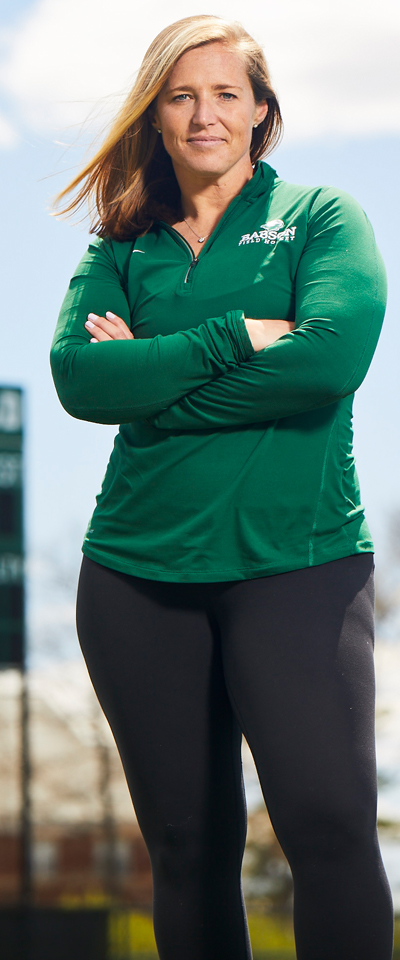
Julie Ryan
Photo: Pat Piasecki
Why was Babson a good fit for you after coaching Division I at Yale and Boston College?
There is a lot of pressure on the student-athletes at the Division I level. Over the last 12 years, I’ve lived the Division III experience, and I truly believe it gives the students the best opportunity to do more than play their sport. They have an incredible amount of balance in their lives, which is an important life skill.
You have an impressive history as an athlete; what was it about coaching that appealed to you?
I think the skills and the experience that collegiate athletics provided were something that I couldn’t imagine not having in my life. When I realized that the opportunity to coach was something viable and realistic for me, I jumped at it. I honestly couldn’t imagine doing anything else.
How does your job as an athletic coach fit into students’ lives at Babson, and beyond?
Our role as coaches is to make sure that we are allowing an opportunity for growth, and to make sure students are prepared for life’s challenges when they leave here. I think Babson does a great job of that academically, but to reinforce that through athletics sets this experience so high on the bar.
You stay in touch with many of the students you’ve coached. Why are these relationships important?
One of my favorite nights of the year is when I invite all the alums I’ve coached to my house for dinner with the team. They tell stories and connect with the current team, which gives them an opportunity to hear about the legacy they’re leaving and truly embrace the experience. I love being part of their growth at Babson, but I am most proud of the impact they make when they leave here. – Jeannine Stein

Illustration: Dongik Lee
An ambitious construction project is now underway that will transform Babson’s fitness and recreation facilities. “It is the largest facilities investment in student and campus life in the College’s history,” says Lawrence Ward, vice president for student affairs and dean of students.
The Babson Recreation and Athletics Center construction will bring needed renovations to the Webster Center and create a 75,000-square-foot addition along College Drive. A groundbreaking ceremony for BRAC was held in September, and work is expected to be done by fall 2019. The project will nearly double the size of Babson’s recreation and fitness space.
Ward says the upgrade in facilities is overdue. The non-climate-controlled Webster Center opened almost 30 years ago and comes up short when compared with sports centers at other schools that prospective students may be applying to. “Our facilities are dated,” Ward says. “They are not up to par.” BRAC also is needed considering how much time students spend on campus. This is their home, and they need a place to unwind and relieve stress. “Healthy body, healthy mind leads to a healthier entrepreneur,” Ward says.
The new facility will occupy the previous location of the tennis courts and Peavey Hall, which housed the varsity weight room. (Eight new tennis courts are being constructed behind Van Winkle Hall.) BRAC will include a two-story fitness center with state-of-the-art equipment; two multipurpose studio rooms for yoga and aerobics; dedicated varsity locker rooms and an expanded sports medicine area; and a recreation space with three courts for pickup basketball or volleyball that also will be used to host large-scale College events.
Ward adds that the building’s classic brick-and-window facade will make for a striking addition to campus. “As you move west along College Drive, you will really feel a new sense of energy,” he says. “It will dramatically transform that end of campus.”—John Crawford
]]>
Illustration: theispot.com/Beppe Giacobbe
Almost nothing takes my breath away like the shimmer of early morning light bouncing off the ocean surface or the chill that wakes up my body and brain as I step into the water for the morning group swim. There are rules for this engagement. Someone is always watching, and no one swims alone. New swimmers or those growing older and less steady on their feet walk into the water holding hands. We are assured that if we endure the initial chill we will be blessed with the healing joy that only swimming in saltwater on Martha’s Vineyard can bring.
But this gathering is not only about the water; it is also about community. People come to share news and to seek and provide support. Every summer, we look forward to those moments when, in spite of whatever life dared to bring us, we are here together on this beautiful island again.—Sadie Burton-Goss, chief diversity and inclusion officer at Babson
For as long as I can remember, my parents, two brothers, and I have escaped our old Kentucky home in the summer months to stay in Atlantic City. Crossing the bridge into the city, we roll down our windows and are overwhelmed with the salty air that my nose will soon become accustomed to but my hair certainly will not. I spend my time on the beach where the ice cream man walks along the shore. When it is too dark to stay, I meander to the boardwalk and am surrounded by sights that you can’t find in Kentucky, from casinos and palm readers to hermit crab shacks and saltwater taffy stands.
As I’ve gotten older, though, I’ve become less enthralled by all the ice cream and mini golf. And I’d say the excitement at the shore has dwindled since so many casinos closed. But I do still go to Atlantic City, and as soon as I roll down my windows, I am greeted with the comfortable familiarity of a home away from home.—Lisa Cole ’18
My husband, Kevin Wittnebert ’02, and I go to Park City, Utah, every summer. We went on a ski trip there once and fell in love with it year round. It is where we plan to retire. We absolutely love it—hiking, biking, boating, paddle boarding, national parks, street markets every day, gorgeous sunsets. There’s just something about the mountains that puts everything in perspective.—Abby Fabiaschi ’02, author of I Liked My Life
Summer unfolds like a peony bloom for me every year. I am surprised by its scents, its layers, its deliciousness. I live on the North Shore of Boston, in the very city, Salem, in which I was born. This sometimes perplexes me, but each summer’s advent reminds me of why, in the words of the great singer and songwriter Jonathan Richman, “I love New England best.”
Summer means travel for most, but I don’t need to go far. My public library is so close that my children learned to toddle and skip by taking the brick sidewalks to the children’s room. In the other direction, I can bike a breezy mile to the ocean and decide whether I want to marvel alongside the tourists on Derby Wharf or enjoy a luxurious, salty-aired, beachside read at Waikiki Beach. And nothing beats a summer night downtown with my longtime neighborhood friends. We slip cool linen over our sunburnt skin and compete in raucous trivia at a pub or sip elegant, sugar-rimmed cocktails on an outdoor patio. My city contains the world in its visitors, its flavors, its streets, and its citizens. I have no reason to leave.—Kerry Rourke, lecturer in English at Babson
]]>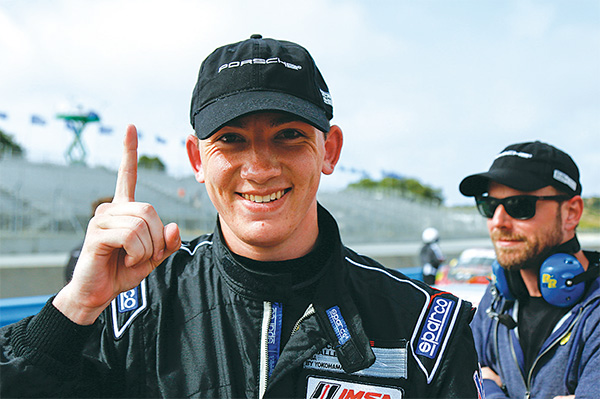
Sebastian Landy ’18 at the Mazda Raceway Laguna Seca in Salinas, California, this spring, when he won the first race in the series
Like most Babson students, Sebastian Landy ’18 has had his fair share of adrenaline rushes (An A? I thought I failed!) and tense moments (That paper is due when?) in the classroom. But unlike most of his classmates, Landy also has experienced thrills and chills on the track as a professional racing driver.
During the summer and in between classes, Landy travels the world to racing series, where he navigates winding courses in sports cars, such as Audis and the Porsche 911, traveling at speeds of up to 160 mph. He wears three layers of fireproof clothing, and the temperature in his car can reach 200 degrees Fahrenheit. And Landy loves it. “I love the adrenaline and creating order out of chaos,” he says. “When I’m in the car, I just get in the zone.”
Landy began racing as a kid when his dad introduced him and his older brother, Forrest ’17, who also races and goes to Babson, to go-karts. At 15, the youngest age at which individuals are allowed to race semiprofessionally, Landy got on the track. And when he turned 16, he started racing professionally.
Landy has a small team—including his dad who serves as his manager—that works with him at every race. But Landy is responsible for much of his own promotion. “Racing is a business. You need to work with companies to find and create partnerships,” he says. “Sponsorships need to create value for the sponsors and for you.” Recently, Landy landed a partnership with a new sponsor, Forto, a maker of coffee-based energy shots. Social media also is a big part of the racing world, and Landy is responsible for all the marketing on his channels, including Facebook, Twitter, and Instagram.
But nothing garners more recognition than winning races, and Landy is doing just that. Currently, he is participating in the Porsche GT3 Cup Challenge USA, a series that races across the country and spans the calendar year. So far he has won three times and finished second twice, which has helped him hover in the top three for the overall championship rankings. While Landy prides himself on his accomplishments, he also tries to learn from his mistakes. “In 2015, I spent a year racing in Europe in the Audi Sport TT Cup. But I didn’t get there as far in advance of the races as I should have, so I didn’t have enough time to review and prepare,” he says. “It was not a good showing, and I knew I could do better.”
Landy says his time at Babson has been invaluable in helping him succeed in the racing world thus far. “Racing is work. The level of professionalism at Babson is something that no other college has and that has helped me learn how to manage myself well in the racing world,” he says.
Whether he will continue to race after he graduates, Landy isn’t sure. For now, he is happy to be a full-time student and a professional racer, straddling two worlds that compete for his time, energy, and business acumen. “I’m lucky to be able to pursue the dreams I have for as long as I have. Less than half a percent of racing drivers make a sustainable career out of this,” he says. “I don’t know if I want to do it forever, but it will always be a part of my life.” —Alexa D’Agostino
]]>
Photo: Cory MacEachern
Roger’s Pub
“Wow” exclaimed alumni on Facebook when a photo of the new Roger’s Pub & Grille was posted this winter, announcing the pub’s reopening. “Can hardly wait to visit.” This latest rendition of the storied pub, sporting a design voted on by the Babson community, is by far the most stylish. But its aim remains the same: to provide a place for folks to hang out and have a good time.
From its humble beginnings in 1974 as the Beaver Brau in the basement of Coleman Hall to its more recent incarnation as Roger’s Pub in Park Manor Central, the campus bar has been a place where undergraduates often go after classes. That’s not to say others wouldn’t join them. But, for the most part, undergraduates dominated the scene.
In its new home alongside Trim Dining Hall, the pub has become a place where even more of the Babson community gathers. “In the later hours, we certainly get lots of undergraduates. But now we often see graduate students dropping in before and after class, and a lot of the staff and faculty come for lunch or dinner,” says Dan Garden, general manager for Trim Dining Hall, which includes the pub. “President Kerry Healey even hosted an event for the trustees.”
With three big TVs, the pub already has attracted sports fans. “We live-streamed a couple of Babson games, including hockey and basketball,” says Garden. And giving a nod to the past, the pub is home to the pool table from the old Roger’s Pub. The new venue also has a large adjacent room, the “Grille,” that opens after Trim Dining Hall closes. The space includes a stage, where bands have played, and a drop-down screen for broadcasts and events, such as movie nights.
“We’ve only been open since mid-January, so we’re still experimenting,” says Garden. He is listening to suggestions from visitors, implementing them when possible. “Someone asked why we don’t have a daily special, so we added one.”
In time, the pub might host more live music, trivia nights, karaoke. Garden even plans to add a Babson-branded beer. “We have the freedom to try new things,” he says. “It’s been fun.”—Donna Coco
]]>Where do your story ideas come from? There’s a fair amount of me and a fair amount of other people in the book. Some of the stuff that’s hardest to write is actually about people I’ve known. I became close with a couple of students when I taught at community college, and they were the kind of kids who should be looking at a future for themselves, but it’s western Pennsylvania, so instead they were focused on reproducing their parents’ postwar, working class lives, and those options aren’t there anymore. They just don’t exist. And so writing about those kids struggling and ultimately failing to work beyond that is tough.
Before becoming a teacher, you worked a bunch of jobs. Tell us about one. I got a job working for Leidy’s Pork Products. It’s every bit as glamorous and fun as it sounds. I had to get a pair of steel-toe rubber boots; they provided the white coat and apron. It was summer and I worked inside a refrigerator, so my nose was running all the time. It was awful. I did not end up a vegetarian, though. People always expect that and I’m like, no, I grew up a German boy in Pennsylvania. There’s no vegetarianism for me.
You taught Lady Gaga in a writing class for gifted teenagers. What was she like? She was a smart kid. She told stories about working with a choreographer and with a vocal coach, and she wanted to be the next Christina Aguilera or Britney Spears. She was very serious about studying the music business at 15, and she made it. She made it about as far as she could go, so I have nothing but admiration for that.
Any hobbies? Reading has always been a hobby. I like gardening. I’m a gamer. I feel like the escapist fictional worlds of video games have become part of my writing process. I write about these kids who break my heart when I think about the choices that they made and the directions their lives went in, and so I come back from the library or the cafe kind of weeping, and I escape into the Xbox and go solve imaginary problems for imaginary people.—John Crawford
]]>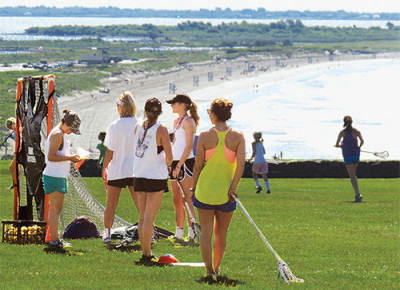
Photo courtesy of Charlotte O’Halloran ’18
Charlotte O’Halloran ’18 (far left) on the field overlooking Sachuest (Second) Beach in Middletown, Rhode Island
Lacrosse and surfing, two sports typically not associated with one another. But they happen to be favorites of Babson lacrosse player Charlotte O’Halloran ’18. “My senior year in high school, my coach and I joked about this million-dollar idea of starting a lacrosse and surfing camp,” she says.
After experiencing FME last year, the idea didn’t seem so crazy to O’Halloran anymore. She decided to bring such a summer camp to Newport County, Rhode Island, where she had attended St. George’s School in Middletown. Her high school alma mater would be the perfect location, thought O’Halloran, with a playing field for lacrosse and easy access to surfing via a campus situated next to a popular beach.
Thinking about her target audience, O’Halloran felt confident that a market existed, and she knew she wouldn’t face any competition. “That motivated me,” she says. “There was this unique opportunity that, if planned right, could be successful. I used a lot of my FME practices when creating this business.”
O’Halloran developed a business plan, made an income statement, and contacted her high school coach to see if she could assist (she wasn’t available). After taking care of both land and water insurance, obtaining multiple permits, and gaining approval at town council, O’Halloran was on her way to realizing the camp she named Chicks that Rip.
Yet more challenges awaited her. Finding the right price point for the camp, convincing St. George’s to open its campus to her business, and hiring staff were just a few. To market the camp, O’Halloran made fliers and delivered them to local gyms and schools. She also emailed every lacrosse club coach in Rhode Island and created a website and Facebook page.
Her drive and hard work paid off as 18 girls, ages 9 to 14, participated in the inaugural camp, and she broke even. Looking ahead to next summer, O’Halloran says there already is a lot of interest, so she probably will have to rework her operations as numbers grow. Even further down the road, she might add a boys component. “I can see staying around Newport for a while,” says O’Halloran. “It’s too picture perfect, playing lacrosse while overlooking the water and surfing in the afternoon. It just doesn’t get much better than that.—Scott Dietz, associate director of athletics
]]>
Photo: Webb Chappell
Sam Sternweiler ’17 (left) and Kai Haskins ’18
For Kai Haskins ’18 and Sam Sternweiler ’17, radio still holds an allure, a magic.
In an age when any kind of music you long to hear can be found on the Internet and sites like Pandora use algorithms to recommend songs, radio offers a personal and intimate experience, they believe. To turn on a station, to hear that voice come out of the speakers, is to invite someone into your life, say Haskins, the president of Babson College Radio, and Sternweiler, the station’s vice president for campus events. “The communal aspect of music still matters,” Haskins says. “Sharing your music with someone is a personal thing. It’s more fulfilling than when an algorithm recommends music.”
Babson College Radio has been heard online since 1998, and today it plays what Haskins describes as an “eclectic smorgasbord” of music. For years, the station made its home in Park Manor Central, but construction necessitated a relocation to Mandell Family Hall. Early in the semester, the station was still recovering from the move. Wires, microphone stands, a disco ball, and lots of records, given vinyl’s resurgence in recent years, were scattered about the studio. But the turntables already were set up and ready to go, and Haskins and Sternweiler were excited about the year ahead. Plans include a live 24-hour broadcast for charity, a show on entrepreneurship, and bringing more bands to campus.
About 30 students signed up to be disc jockeys, which is easily double the usual number. To get to know the new DJs, Haskins and Sternweiler asked them to turn in an eight-song playlist and to explain why they picked their songs and in what order the songs should run. “Order matters,” Haskins says.
The station is on air 24/7. Haskins and Sternweiler hope to have the DJs playing music 24 to 30 hours a week (when no one mans the studio, the station broadcasts a long, continuous playlist). To increase the station’s visibility, Sternweiler also DJs at one or two campus events every week. He loves seeing how the music he plays affects people, how it makes them sing and dance. “That’s a satisfying feeling,” he says.
To hear Babson College Radio, go to Trim Dining Hall, where the station is streamed throughout the day, or visit babsonradio.com. In a typical month, the site has about 3,000 listeners, though Sternweiler doesn’t care about the size of the audience. He takes to the microphone to share some of himself and his music. “The feeling that someone might be listening makes it all worthwhile,” he says.—John Crawford
]]>You must find fishing relaxing. It’s not relaxing at all. Show me a patient fisherman, and I’ll show you someone who doesn’t catch a lot of fish. It takes a lot of thinking about what you’re seeing, and understanding the reactions of fish to what you’re doing. If you’re just sitting there waiting for them to do something, you’ll be less successful.
Did you fish much when you were a kid? I spent a lot of my youth pedaling around on bicycles with a friend. We probably fished every pond within a 15- mile radius. We’d leave in the morning and come home for supper. I was 10 or 11. We would pack our lunch and head on out.
What’s the most memorable place you’ve ever fished? The one that sticks out the most is Russia, fishing for Atlantic salmon in what is called the Northern Rivers. It was an incredibly beautiful place, and it was very wild. We rode an hour-plus into the wilderness in these old, rattling helicopters. The fish coming up those rivers are the best examples of Atlantic salmon.
How did you start working at the Salt Water Sportsman? An acquaintance persuaded me to give it a try. I had no journalistic background at all. I gave it a shot, and I never looked back. He and I eventually bought the company. It was a sleepy, well-respected publication, and we turned it into the largest saltwater fishing magazine in the world. Through that, I got into fisheries management issues.
Why are you so involved with conservation? I was fortunate enough to combine an avocation and a vocation and do pretty darn well at it. I still have a sense that I have an obligation to give back to the resource that gave me this very good living. Another part is I enjoy the fishing experience and want to make sure it’s around for my grandchildren and their children. I want to make sure there’s still fish out there.
What do you do when you’re not fishing? I do what everyone else does. I work on the honey-do list.
How did you get your nickname? It was a family thing. It takes too long to explain.—John Crawford
]]>A shift leader at Bowl-O-Rama, Zoffoli checks people in and rents them shoes at $3 a pair; the sizes of the regulars she knows by heart. If a Merry Mixer bowls an exceptional game, she awards her a prize. “Come on down, you have won a free game pass,” she says into the microphone. If a pinsetter jams, Zoffoli winds her way behind the lanes to get the game moving again. When she does, the Merry Mixers applaud.
Zoffoli works for Nick Genimatas, MBA’76, who co-owns the Portsmouth, N.H., bowling alley with his sister. Their father opened it in 1956, and Genimatas started working at Bowl-O-Rama when he was 8 or so, serving hamburgers and dishing out ice cream at the snack bar. “I like being here. It’s an enjoyable place to be,” says Genimatas, surrounded by the rhythms of the bowling alley: the rolling of the balls, the smack of the pins, the beeps of the arcade. He has trouble picturing himself working in a more buttoned-up environment. “Could I have been a corporate guy? I don’t know.”
Business at Bowl-O-Rama fluctuates with the seasons and the weather. On a sunny summer day, Bowl-O-Rama becomes a ghost town where tumbleweeds practically blow across the lanes. Things change in winter. When the air grows cold and harsh and the days of beaches and baseball are out of reach, a place like a bowling alley becomes a respite, an oasis of pizza and beer, spares and strikes, sport and competition. “A snowy day is our busiest day,” Genimatas says. “Parents are scrambling for things to do.” During such times, a welcoming hangout can be essential to staying active, and staying sane.
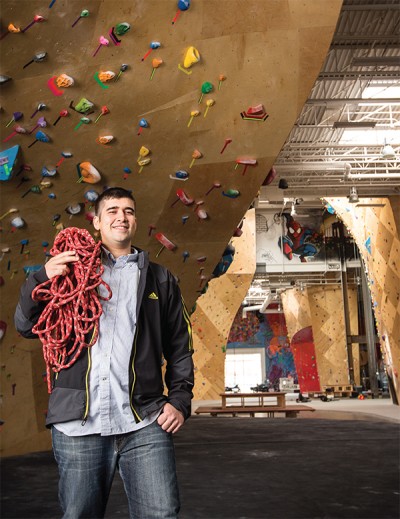
Lance Pinn ’06 in Brooklyn Boulders’ vast climbing
facility in Somerville, Mass.
Venturing High Above
How important is staying active in the winter? When Lance Pinn ’06 came to Babson, he had lived previously in California and Virginia, so winter hit him hard. Hunkering down indoors, he dreaded venturing out. “I had never been to New England,” he says. “I had never experienced cold weather.”
He’s better prepared now. Today, he is co-owner and co-founder of two Brooklyn Boulders rock-climbing facilities: one in Brooklyn, N.Y., the other in Somerville, Mass. If someone were in need of a way to beat the winter blues, a rock-climbing facility makes for a good spot. On a Tuesday morning, Pinn stands in the Somerville location, which is long and large, 40,000 square feet, full of walls to climb and challenges to take on. Pinn is looking up at his fellow co-owner and co-founder, Jeremy Balboni ’05, who scales the wall like a spider. Near the top, 49 feet above the ground, Balboni climbs upside down on a part of the wall known as the “tongue.” He then dangles from the ceiling from a rope and sinks back to earth. “He’s nasty,” says Pinn, watching his partner.
An avid climber who first turned Pinn on to the sport, Balboni enjoys the physical discipline and problem-solving skills that climbing requires. It also forces him to focus. “You’re truly in the moment,” he says. “You’re living for that one second in front of you.” Pinn remembers his initial foray into climbing with Balboni, how nervous Pinn was at the start and how astonished and excited he felt by the end. “All you think about is getting back on the wall,” he says.
Together the pair revisited a business plan for a climbing facility that Balboni had written while at Babson. After an exhaustive 18-month search to find the right location, they opened their first climbing gym in Brooklyn in 2009 with Stephen Spaeth ’05 (who has since moved on to a career in film production). They soon noticed how much the climbers enjoyed hanging out at the facility. Sitting with their laptops and talking for hours, they turned the gym into a vibrant community, one that sees 60,000 unique visitors annually.
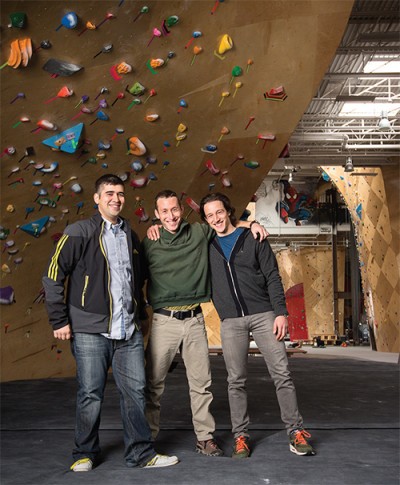
Lance Pinn ’06 (left to right), Jesse Levin ’08, and Jeremy Balboni ’05 are partners in the climbing venture.
Pinn and Balboni wanted to create even more of a community vibe when they, along with four other partners (including Jesse Levin ’08 and Brandon Bell, MBA’12), opened the Somerville Brooklyn Boulders last year. So besides climbing, the facility offers saunas, cardio machines, a weight room, lounge, and collaborative work space. As many as 300 people fill the location during its busiest times, giving the space a hum of activity. “We tried to create an environment where you don’t want to leave,” Pinn says. “We want you here for five or six hours.” During that time, Pinn envisions visitors climbing, meeting people, doing some work, and feeling inspired. Spread throughout the location is art of all types: woodwork, metalwork, graffiti, photography, and motorcycles displayed like museum pieces. Above it all, written near the ceiling, are the words “Exist to Inspire.” “We hope you have an epiphany at our space,” Pinn says.
More Brooklyn Boulders are slated to open in the near future: Queens, N.Y., and Chicago this year, Manhattan in 2015. As they expand, the Brooklyn Boulders team will be thinking of this number: three. That’s the percentage of Americans who go climbing at least once a year. A big obstacle to growth is convincing the other 97 percent to give climbing a try. “Most people don’t think they can do it,” Pinn says. “Most people assume it’s about upper body strength.” In actuality, climbing is much more about using one’s legs, he says. Climbers step first with their legs and then reach with their arms. “If you can climb a ladder, you can climb a rock wall,” Pinn says. “The first step is being able to realize you can do it.”
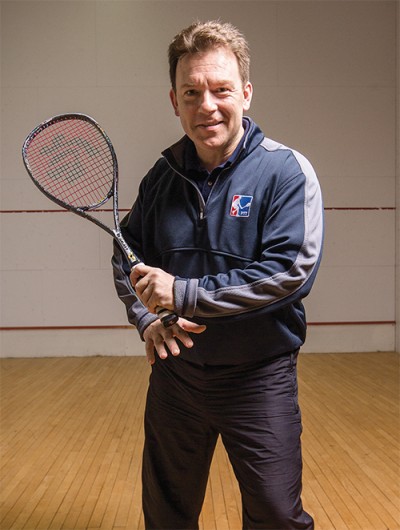
Joe McManus, MBA’06, CAM’08, of the Pro Squash Tour, which stages tournaments for professional players
Intensity in a Box
Joe McManus, MBA’06, CAM’08, also enjoys an intense indoor activity, but his sport of choice is more earthbound, and a lot more claustrophobic. Inside a 32-by-21-foot box, he hurls a small rubber ball at the wall while trying to outsmart and outmaneuver his opponent, who often seems right on top of him in the small space.
This is the sport of squash, and it’s full of sweat, speed, and strategy. “Some people have called it chess at 150 mph,” he says. With squash, McManus not only has found a rigorous workout, one that can burn up to 1,000 calories in an hour, but also a business and profession. He is head squash coach at Tufts University and commissioner, CEO, and founder of the Framingham, Mass.-based Pro Squash Tour, which stages tournaments for professional players in the U.S. and abroad. With the tour, McManus is shaking up a growing sport that for years seemed relegated to country clubs and preparatory schools. In some staid squash circles, he’s even considered controversial. “If you’re into squash,” he says, “what I do is a bit unusual.”
McManus first played squash as a young man, but the sport took awhile to turn into a career. His life has seen various twists and turns. “I always wanted to be the kid who at 15 knew who he wanted to be,” he says. “I wasn’t.” He majored in classical music performance, worked as a teacher, did political consulting, served as executive director of the American Diabetes Association, and worked in China as a business consultant.
Through the years, though, he hankered to start a business, and he came to Babson to learn how to do just that. In squash, he saw a great opportunity. Twenty million people play the game worldwide, and squash players in the U.S. tend to be highly educated and affluent. “If you add up all the squash fans in America, it’s a great demographic to market to,” McManus says.
He started his tour in 2009. From the beginning, he wanted to try new ideas and be entertaining. “Squash is a great sport, but it’s very dry,” he says. McManus tweaked the rules, and he added touches that wouldn’t be out of place during an NBA game: music, player interviews before and after matches, and a remote-controlled indoor blimp hovering over the audience. He launched Squash Ezine, a weekly newsletter that includes Truth and Rumors, a popular column giving a gossipy rundown of squash happenings.
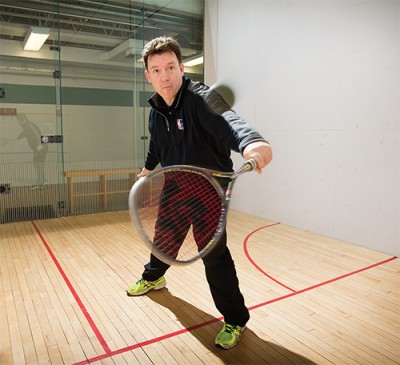
Joe McManus’ squash tour has made some tweaks to the game. “If you’re into squash, what I do is a bit unusual,” he says.
During the tour’s first tournament, he had women in provocative outfits stroll out holding signs announcing each game. McManus admits he went too far with this bit of envelope pushing. A sight common in boxing matches didn’t work in the intimate confines of a squash court. “It was the wrong thing to do,” he says. “It was a nightmare.” The women never made another appearance, but they left an impact. Five years later, McManus is still asked about the stunt.
To play on a professional squash tour is not the same as playing professional tennis or golf. Players aren’t getting rich, McManus says. Still the tour has seen success. It has three circuits: Canada; Asia-Pacific, with stops in countries such as Vietnam, Malaysia, Indonesia, and the Philippines; and America, which has about 20 stops in the U.S. Up to 30,000 people have watched live streams of matches on the tour’s Pro Squash TV site.
The antics and ambition of the new tour have resulted in a squabble with squash’s establishment. The Professional Squash Association, which is based in England and organizes elite tournaments around the world, has banned its players from participating in the upstart Pro Squash Tour.
Initially, McManus looked at legal options to lift the ban, but decided against pursuing them. He believes the squash association, which has been around for decades, is trying to strangle competition. “America is a growth market,” he says. “They’re aware of that.”
McManus actually thinks the friction with the association can be good for his tour and the sport. He doesn’t mind stirring things up a little. “If you’re not, you’re not doing anything of interest,” McManus says.
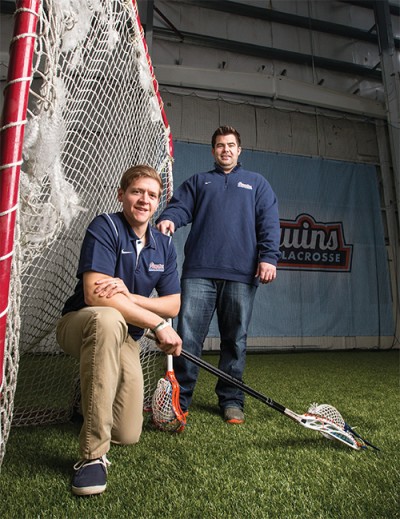
Jason Wellemeyer ’08 (left) and Tyler Low ’09 of PrimeTime Lacrosse
A Summer Sport in Winter
On first blush, lacrosse wouldn’t seem to be a good wintertime activity. Squash. Climbing. Bowling. These make sense. But think of lacrosse, and you picture green fields, open skies, and athletes running in the breeze.
For sure, PrimeTime Lacrosse, co-owned and co-founded by Tyler Low ’09 and Jason Wellemeyer ’08, offers plenty of lacrosse activities when the weather is warm. In the summer, PrimeTime runs 30 to 40 day camps throughout New England, the mid-Atlantic, and Texas. It also organizes 30 select teams for elementary through high school students, and as many as 3,000 players will enroll in their camps and clinics throughout the year.
PrimeTime doesn’t close, though, when the temperatures plummet. The game continues inside its Natick, Mass., facility. Located across from a dog-fence company in an industrial area, the facility can be easy to miss. PrimeTime’s building is non- descript, the sides covered in corrugated metal, but in a window a picture of a penguin with a lacrosse stick lets visitors know they’re in the right spot.
Immediately inside are offices and a place for players and families to hang out. Children watch TV and do homework, and a golden retriever named Charlie lounges in Wellemeyer’s office. Wellemeyer himself may be about to jet off to a PrimeTime event in another state, or he may fill you in on his latest exploits and misadventures on the lacrosse field. Both he and Low played lacrosse at Babson, and they still play as part of an adult team sponsored by PrimeTime. They’re also lacrosse coaches at the University of Massachusetts Boston. “My thumb is probably broken and my shoulder is a mess,” Wellemeyer says. “It’s part of the game.”
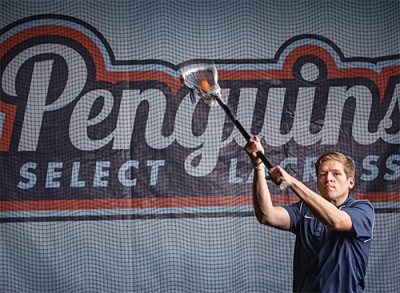
PrimeTime’s Natick, Mass., facility allows lacrosse players to work on fundamentals during winter months.
Walk to the back of the building, and the facility opens into a long and wide space, 100 feet by 55 feet, that used to be a factory. With green turf on the ground and nets at either end, the space allows players to work on the game’s fundamentals—catching, throwing, picking a ball off the ground—when fields are covered in snow. “It’s constantly busy,” Wellemeyer says. “We’re a year-round operation.”
PrimeTime can operate year-round because lacrosse’s popularity has soared in recent years, as the sport has moved beyond the Northeast where it’s traditionally played. Low and Wellemeyer started PrimeTime in 2007 when they were still students at Babson, and they’ve watched as demand for their offerings increases. Having an indoor space became a necessity. “We’ve grown with lacrosse,” Wellemeyer says. “It’s the new sport that’s taking over.” Athletes are drawn to lacrosse’s speed. In comparison, baseball seems slow. “Football and hockey players are looking for another fast-paced game,” Low says.
Low and Wellemeyer hope they influence players beyond lacrosse. Besides the skills and drills, they want to teach “the things that may go by the wayside these days,” Wellemeyer says. They focus on sportsmanship, dedication, teamwork, and respecting others. “It allows us to teach values,” Low says. “It’s less about wins and losses and more about preparing them for other aspects of their lives.”

He may be co-owner of a bowling alley that has been in his family for nearly 60 years, but Nick Genimatas admits that his bowling skills are lacking.
Let the Good Times Roll
At the Bowl-O-Rama Family Fun Center, the balls continue to roll down the lanes and crack into the pins. After a while, the constant racket blends together, becoming almost like white noise.
These are the sounds Nick Genimatas has known his entire life, ever since his father and two partners paid $15,000 each to start Bowl-O-Rama. To buy the 20 pinsetters they needed, the partners put down $25 for each machine. “There’s a lot of nostalgia here,” Genimatas says. “We’re proud of the 57 years under one family.”
Through the years, Genimatas has watched how the business of bowling has changed. In the early days of Bowl-O-Rama, 60 to 70 percent of its business was league play. Stay-at-home moms played in leagues during the day, and employees of local businesses filled the rosters of nighttime leagues. The Portsmouth Naval Shipyard had a couple of leagues. The Portsmouth Herald had one. Today, leagues make up only 15 percent of the bowling alley’s business. More women work nowadays, and people no longer stay at the same company their whole lives, making friends and socializing together. “Bowling, in a way, is reflective of society,” Genimatas says. “Bowling has changed because society has changed.”
That’s not to say business isn’t good at Bowl-O-Rama. It hosts lots of birthday parties and corporate events, and its arcade and cafe, which sells beer and wine, are solid moneymakers. And the bowling alley still grows busy with people looking to spend time with friends. On weekends, the house lights are turned down and the music and disco lights are turned up for “cosmic” bowling. When young children visit, the lanes are fitted with inflatable bump-ers to prevent the youngsters from throwing the ball in the gutter.
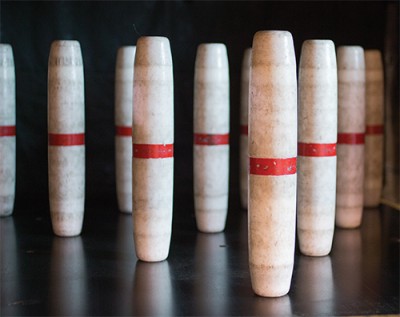
Strong leagues still call Bowl-O-Rama home. On Wednesday night, the serious competitors of the Men’s Classic League gather. Last year, the league’s prize fund was $18,000. When they bowl, the music in the bowling alley is turned off, the men needing to concentrate as if they were putting a golf ball. On Tuesday mornings, the Bowling Belles congregate. That group’s oldest member, Evie, is about 90 and walks with a cane, and when Bowl-O-Rama employees see her coming, they carry her bag of bowling balls for her. “The lady has great spirit,” says Genimatas, who points out that Bowl-O-Rama, like many New England bowling alleys, features the Candlepin style of bowling. Candlepin balls are lighter and smaller than typical bowling balls, so they’re easier for seniors and children to use. “If you’re 3, you can roll it between your legs,” he says.
The good times do roll at Bowl-O-Rama, but Genimatas is 61, and he turns wistful when thinking of the future. None of the family’s next generation seems interested in taking over Bowl-O-Rama, and if the center is sold, the new owner may not keep it a bowling alley because land in the area is so valuable. That makes Genimatas think of all the people through the decades who have come to the bowling alley for parties, reunions, and those snowy winter days. “People in the area have been here, one time or another,” he says. “We’ve been an integral part of the community.” So far, though, Genimatas has no plans to hang up his bowling shoes and retire. “Why rush it?” he says. “Bowling is something I could do for a long time.”
]]>